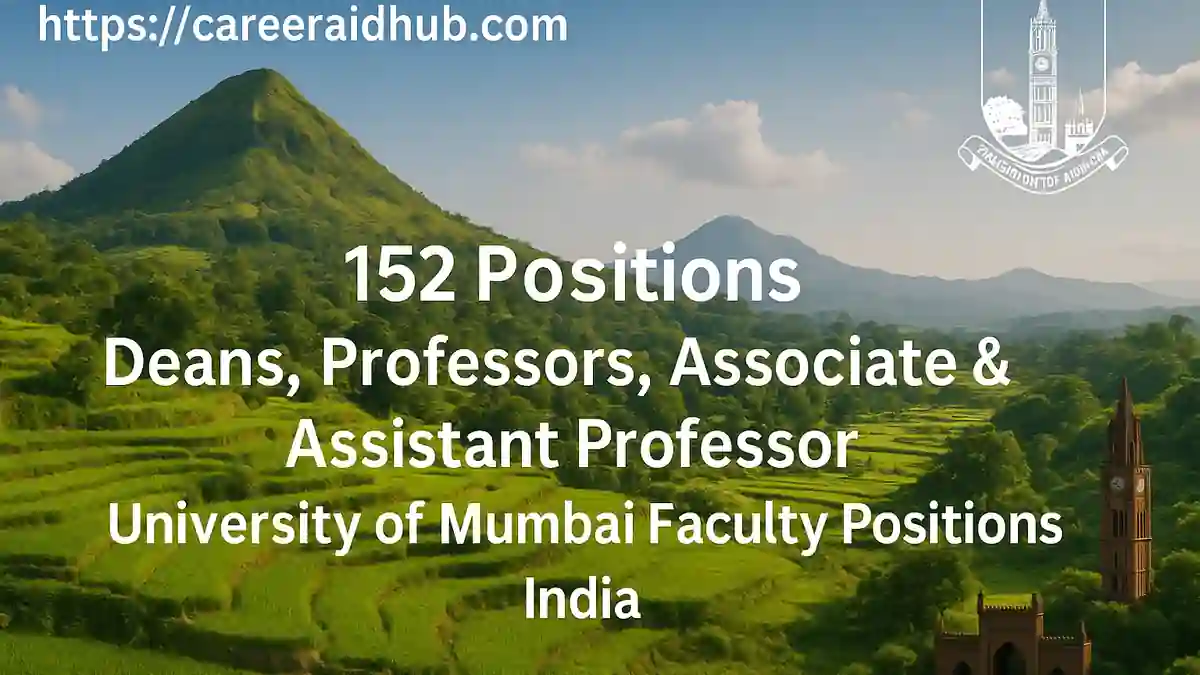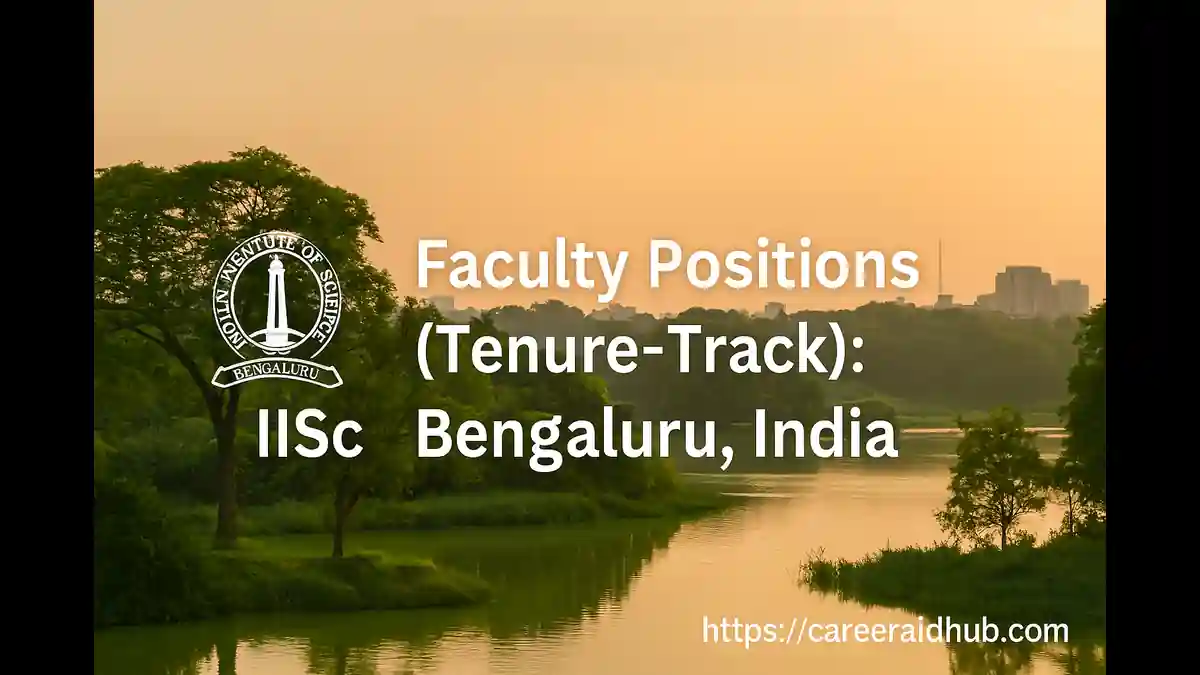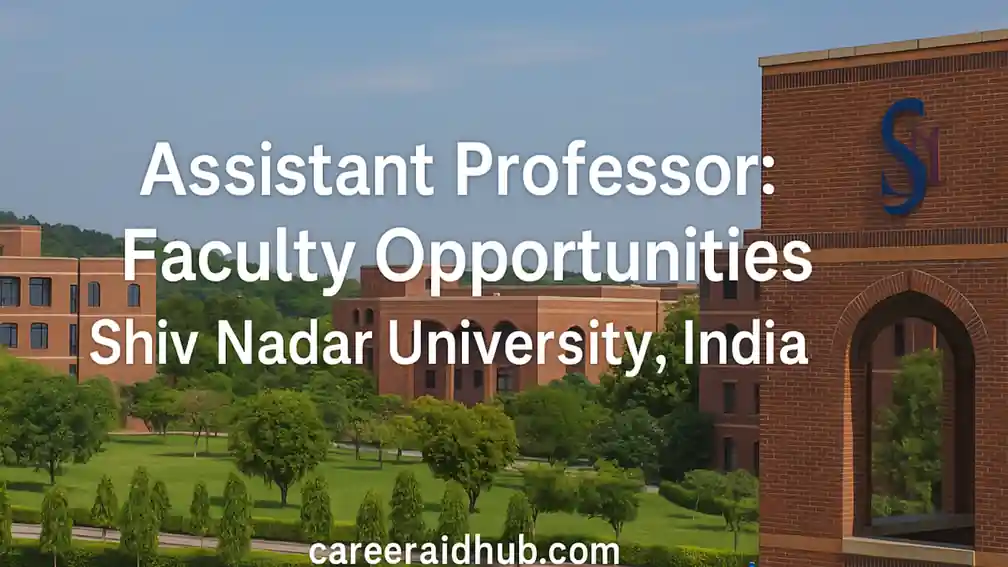TIFR Hyderabad Faculty Recruitment: How to Apply, What They’re Hiring For, and How to Stand Out
Tata Institute of Fundamental Research–Hyderabad (TIFR-H) welcomes applications for Assistant Professor and Associate Professor positions across priority areas in Physics, Chemistry, Biology, and Mathematics & Computer Science. The call operates on a rolling basis, enabling candidates to apply when their dossiers are strongest and their project vision is fully articulated. The centre provides internationally competitive start-up packages, robust intramural funding pathways, and state-of-the-art shared facilities, creating favorable conditions to launch or scale high-impact, curiosity-driven research programs.
Why TIFR-H?
TIFR-H is a dynamic centre in the TIFR network, designed for interdisciplinary discovery at the frontiers of basic science. Faculty collaborate within and across laboratories, co-supervise graduate researchers through TIFR’s degree programs, and regularly connect with national and international partners. The culture emphasizes methodological rigor, open science where feasible, reproducibility, and collaborative problem-solving. For emerging group leaders, this combination—intellectual autonomy plus institutional scaffolding—often translates into rapid early outputs, sustained visibility, and a strong platform for competitive external grants.
Open Areas: What TIFR-H Is Looking For
A) Physics (Assistant/Associate Professor)
TIFR-H seeks physicists whose research deepens fundamental understanding and opens technology-relevant directions. Illustrative emphases include:
Condensed-matter physics: nonequilibrium phenomena (classical/quantum), ultracold atoms, correlated systems (including computational and data-driven approaches), and soft/active matter that
bridges physics and biology.Quantum matter & technologies: quantum circuits, device physics, quantum sensors and metrology, and emerging quantum materials with measurable advantages in coherence, control, or topology.
Optics & spectroscopy: light–matter interactions across regimes, circuit-QED, intense-laser physics, and quantum optics with clear experimental or theoretical leverage.
Dynamical & nonlinear systems: turbulent or relativistic flows, plasmas, quantum chaos, and complex fluids—including bio-fluid dynamics where physics meets physiology.
Physics of life: evolution, information processing in living systems, biophysical control, cancer physics, and morphogenesis—areas that reward joint work with chemists, biologists, and applied mathematicians.
B) Chemistry (Assistant/Associate Professor)
Priority is placed on synthetic chemistry that advances capability and insight:
Total synthesis of natural products, emphasizing strategy, selectivity, and scalable routes to complex scaffolds.
Carbohydrate chemistry, including glycoscience tools that enable chemical biology, therapeutics, and materials.
Novel synthetic methodology, from activation modes and cascade design to green and photo/electrochemical methods with clear generality.
C) Biology (Assistant/Associate Professor)
Biology recruitment focuses on collective and emergent properties in living systems across scales, with current emphasis on Molecular, Cellular, and Organismal Physiology. Strong applications typically unite quantitative experiments with theory or computation, and
D) Mathematics & Computer Science
The centre invites applications in Data Science, Artificial Intelligence, and Machine Learning, anchored in firm mathematical foundations. Competitive proposals explain the core intellectual contribution, the interface with natural sciences (e.g., inverse problems in physics, sequence modeling in biology, or algorithmic discovery in chemistry), and credible pathways to reproducible, well-documented software.
Eligibility and Level of Appointment
A PhD in a relevant discipline with a strong, field-appropriate publication record.
Postdoctoral experience (typically ≈2+ years) is generally expected; exceptionally strong cases may be considered with flexibility.
Academic rank (Assistant vs. Associate Professor) is determined by credentials, independence, and impact.
Faculty will teach and mentor in the graduate program while maintaining an internationally visible research agenda.
What review committees look for: independence of thought, a clear research program with original questions, evidence of technical leadership (methods, codes, datasets, or instrumentation), and a mentoring plan that develops students as co-authors and future peers.
Funding, Start-Up, and Facilities
TIFR-H offers comprehensive start-up support to set up your laboratory swiftly—covering equipment, essential consumables, and early personnel where appropriate. The institute provides internationally competitive packages and access to high-end shared facilities, enabling sophisticated measurements, imaging, computation, or synthesis without duplicating capital equipment. The funding environment is complemented by intramural support and administrative help for external grants, allowing group leaders to focus on science first while building durable collaborative networks.
How to Apply (Step-by-Step)
1) Scan fit and priorities
Map your research agenda to the centre’s listed domains (e.g., condensed matter, quantum technologies, total synthesis, physiology, AI/ML). Strong proposals articulate why TIFR-H is the right home—instruments, colleagues, and collaborations you will activate in year one.
2) Apply online
Register on the official TIFR-H faculty portal and submit your application packet. The portal details required sections and file formats after login, reducing back-and-forth and ensuring complete dossiers at first submission.
3) Prepare the core dossier
Use the sample application format as a checklist: identity and degrees; complete publication list; five most significant works with your contribution; a research statement (3–5 pages) with aims, methods, and milestones; a teaching statement with graduate-level ideas; and a referee
4) Line up references
Select referees who can testify to originality, independence, and leadership potential. Share your latest CV and a one-page three-year plan so letters can speak to your strategy rather than only past achievements.
5) Email for queries
For clarifications on fit, dossier sections, or the portal, write to [email protected] (cc: [email protected]). Use a descriptive subject line (e.g., “Faculty Application — Quantum Sensing & Nonlinear Spectroscopy”).
6) Mind the timeline
This is a rolling call. Submitting early places you in the next evaluation cycle and helps you coordinate with ongoing commitments (e.g., grant end-dates, thesis defences, or postdoc completions). Plan for interview availability and be ready to discuss lab establishment within the first 12–18 months.
What a Competitive Application Looks Like
Problem–program fit: Your questions and methods must push the listed thrusts forward while showing distinctive intellectual ownership. Replace generic aims with specific hypotheses and decidable milestones.
Evidence of independence: First/last-author papers, corresponding authorship, solo conceptual contributions, and methodological assets (protocols, code, datasets, instruments).
Three-year plan: Define Aims 1–3, specify techniques and collaborations, outline risk mitigations, and connect outputs to journals, datasets, or preprints with credible timetables.
Facility alignment: Name the core facilities and instruments you will leverage; flag any specialized equipment in the start-up list.
Mentoring & teaching: Propose a graduate course and a research seminar aligned to your program, framing how students will grow into co-authors.
Interdisciplinary links: Show concrete touchpoints with adjacent groups—for example, quantum devices for biosensing, machine-learning methods for spectroscopy, or theory–experiment loops in nonequilibrium systems.
Practical Tips Before You Hit “Submit”
Show early traction. Include preprints, software repositories, or pilot data that demonstrate momentum and feasibility.
Quantify impact. Cite selected indicators—citations, invited talks, best-paper awards, software downloads—while focusing on substance over metrics.
Plan for scale. Explain how start-up enables capability within 12–18 months: instrumentation, key personnel, sample or data pipelines, and external-grant positioning.
Right-size teaching. Pair one graduate module with a topics seminar; align both to your research to create mutual reinforcement between teaching and lab output.
Diversity & inclusion. Present a safe, equitable lab culture: mentoring plans, authorship norms, code of conduct, and recruitment practices that broaden participation.
Governance readiness. For sensitive areas, confirm ethics, data, or export-control pathways (e.g., ATAS) and note timelines so onboarding stays on track.
Frequently Asked Logistics
Is this a rolling call? Yes. Applications are reviewed through the year; submit when your dossier is strongest.
Where do I apply? Through the official faculty recruitment portal linked from TIFR-H Careers.
Will I teach? Yes. Faculty supervise graduate researchers and contribute to the course portfolio.
What about start-up? TIFR-H offers comprehensive, internationally competitive start-up, complemented by shared core facilities.
Citizenship/relocation questions? Write to the recruitment addresses with concise context; indicate earliest availability and constraints.
Next review windows? Rolling reviews commonly cluster around academic terms; plan dossiers accordingly.
How This Fits Within TIFR
TIFR operates multiple centres across India and accepts faculty applications year-round. TIFR-Hyderabad’s call sits within this broader framework and particularly favors cross-pollination—for example, physics–life science interfaces, computation-enabled discovery in chemistry, or mathematically grounded AI that illuminates experimental data. Candidates who articulate clear bridges across disciplines often find strong resonance with TIFR-H’s mission and facilities.
Cycle Planning & Updates
Current status: Rolling recruitment—applications accepted throughout the year.
Next cycle outlook: Expect clustered evaluation activity around April and October based on typical academic rhythms; we will update soon as internal calendars are confirmed.
Maintenance plan: Review this page each quarter to refresh priority areas, portal notes, and sample-format revisions.
Feature Table (at-a-glance)
| Feature | Details |
|---|---|
| Program Name | TIFR-Hyderabad Faculty Recruitment (Assistant/Associate Professor) |
| Host Country | India |
| Funded By | Tata Institute of Fundamental Research – Hyderabad (intramural support; start-up packages) |
| Duration | Tenure-track/regular faculty appointments (as per institute norms) |
| Study Mode | Full-time, on campus; research, teaching, and graduate mentorship |
| Eligibility | PhD in relevant field, strong research record; postdoctoral experience typically expected; rank depends on credentials and impact |
| Financial Support | Internationally competitive start-up, access to shared core facilities, intramural support; eligibility to pursue external grants |
| Fields of Study | Physics; Chemistry; Biology; Mathematics & Computer Science (with specified emphases) |
| Deadline | Rolling; applications accepted through the year |
| Official Website | Careers Faculty Positions |
Conclusion
TIFR-Hyderabad offers an outstanding platform for scientists who combine depth in fundamentals with a taste for collaboration and clear research direction. If your dossier demonstrates independence, a realistic three-year plan, and facility-aware execution, this rolling call can translate into a timely appointment and a thriving lab. Prepare a complete, carefully argued application; line up strong referees; and apply through the official portal.
Frequently Asked Questions
Yes. TIFR Hyderabad accepts faculty applications year-round. Submit when your dossier is strongest to enter the next evaluation cycle and align with your transition timelines.
TIFR Hyderabad invites applications in Physics, Chemistry, Biology, and Mathematics & Computer Science, with emphasis on interdisciplinary research and strong methodological foundations.
You typically need a PhD, a strong publication record, and postdoctoral experience. However, the committee may consider exceptional candidates with demonstrable independence.
Use the official TIFR Hyderabad careers portal. Register, complete the online form, upload documents, and submit referee details as instructed.
Prepare a CV, publication list, significant works, research statement, teaching statement, and referees. Follow the institute’s sample application format.
Yes. The institute provides competitive start-up support and access to shared research facilities so new groups can launch quickly and scale effectively.
State clear aims, methods, milestones, facility needs, and collaborations. Then show feasibility within 12–18 months and outline training plans for graduate students.
Yes. Faculty teach graduate courses, mentor students, and integrate research with training activities while building an internationally visible program.
Demonstrate independence, problem–program fit, specific deliverables, facility alignment, and credible plans for publications, software, or datasets.
Yes. International applicants may apply. However, they should plan timelines for relocation, approvals, and onboarding as per institutional guidelines.










